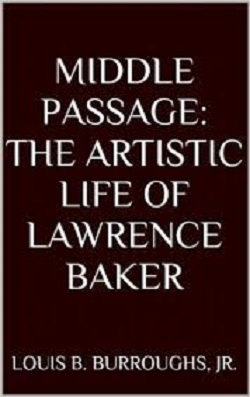Middle Passage
The Artistic Life of Lawrence Baker
This ghostwritten autobiography of an African American artist is reminiscent of Richard Wright or Maya Angelou.
“Color theory says that black, the absence of all colors, matters; and that white, the presence of all colors, matters,” Louis B. Burroughs, Jr. writes in Middle Passage: The Artistic Life of Lawrence Baker, his ghostwritten autobiography of a fellow Ohio artist. The book is thus not only an evocative, eventful life story that moves from the Jim Crow South to the North, but also a forceful artist’s manifesto arguing the merits of African American art.
Baker grew up in Jacksonville, Florida, in the 1950s. His mother, Chilonia, pinched pennies to provide for Lawrence and his numerous half siblings. Baker graduated from an all-black high school and sidestepped gang violence and sex addiction to start college. After an academic suspension reduced him to unloading chicken crates and drinking, Baker took a bus to Cleveland, where, at the age of nineteen, he first met his father. He completed graduate studies at Kent State and taught art in Ohio elementary schools for thirty-five years while pursuing his own artistic development in evenings and weekends.
Burroughs writes in Baker’s voice, a narrative decision that works surprisingly well. The perspective never feels secondhand; the first-person narration is intimate, especially in sections where Baker is an angry young man trying to negotiate a path between stereotypical images of black folk (like Aunt Jemima and Uncle Tom) and new figures from the Black Power movement. “I wandered the streets with various visions following me like a flock of black birds. … Who had time for reason when anger elevated one’s status?” he asks.
The title is a powerful reference to the slave trade. Indeed, Burroughs consciously crafts Baker’s autobiography as an “up from slavery” narrative reminiscent of Richard Wright and Maya Angelou—with “slavery” in this case being poverty and racism. Details about slave codes, Jacksonville’s racial hierarchy, and the legacy of African music and spirituality connect this African American life story to previous generations. Family photos and reproductions of Baker’s art (especially color portraits and black-and-white nature sketches) are an excellent addition, while creative chapter titles (“School Shoes and Sambo” and “Manchild in Cinderella Land”) give the information thematic as well as chronological significance.
The epilogue on black art will be a useful tool for art history students and successfully situates Baker in his historical context. When Baker once collapsed for no obvious physical reason, he drove himself to a psychiatric hospital, where a Haitian doctor gave him some profound advice: “Use your art to take back your identity and cure that which is traumatized in you; only then will you find peace.”
This out-of-the-ordinary book is a cathartic story of overcoming a disadvantaged background and making one’s own luck through art.
Reviewed by
Rebecca Foster
Disclosure: This article is not an endorsement, but a review. The publisher of this book provided free copies of the book and paid a small fee to have their book reviewed by a professional reviewer. Foreword Reviews and Clarion Reviews make no guarantee that the publisher will receive a positive review. Foreword Magazine, Inc. is disclosing this in accordance with the Federal Trade Commission’s 16 CFR, Part 255.

